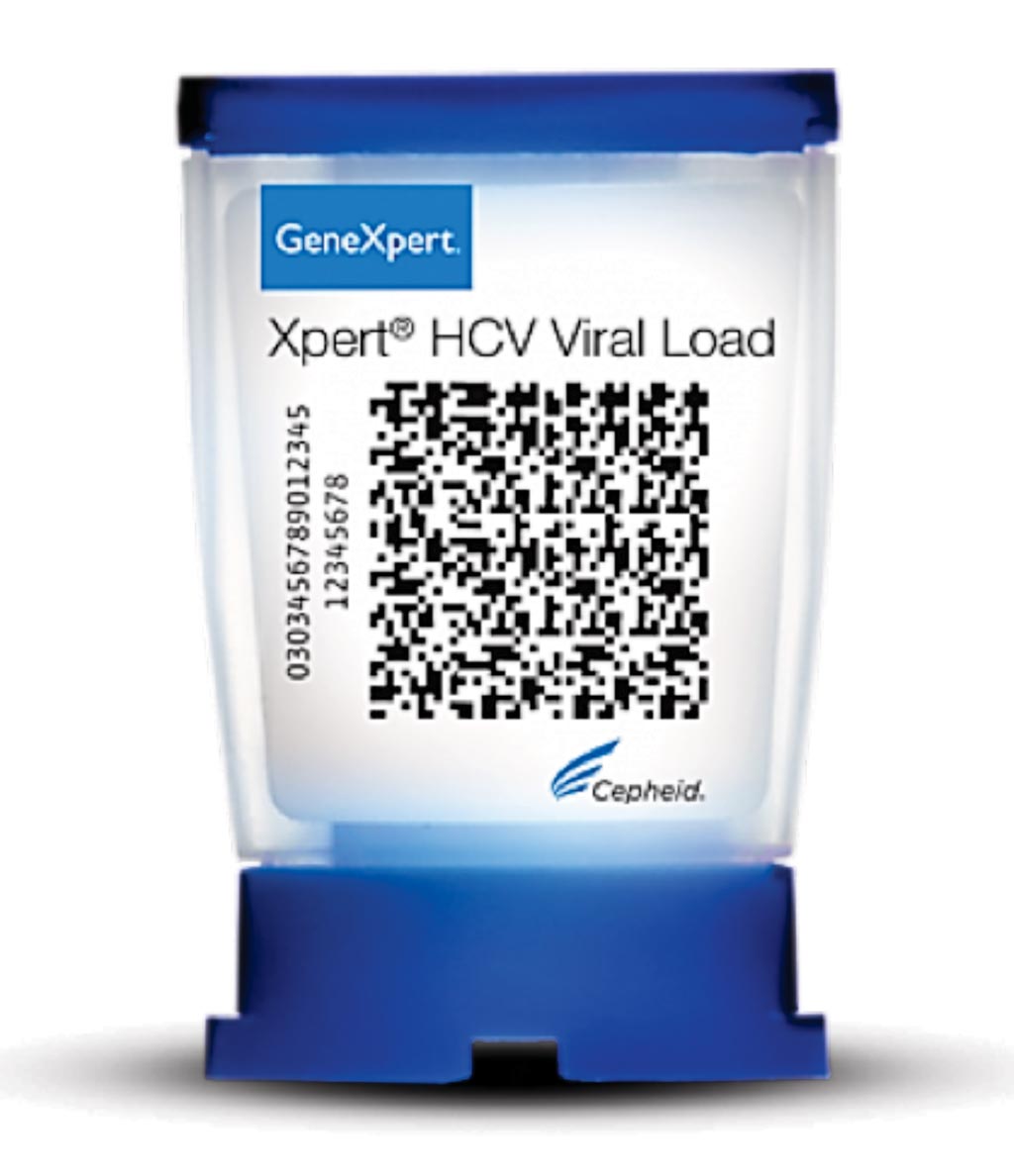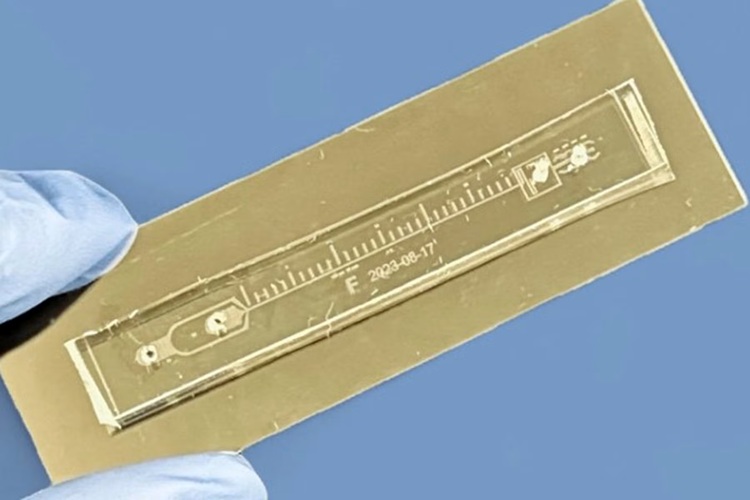POC Test Advances Hepatitis C Diagnosis
|
By LabMedica International staff writers Posted on 10 May 2017 |

Image: The Xpert HCV Viral Load cartridge, a quantitative test that provides on-demand molecular testing for confirmation of infection and monitoring of Hepatitis C virus (HCV) (Photo courtesy of Cepheid).
A new test that enables diagnosis of hepatitis C infection in a single visit could improve access to early diagnosis, monitoring, and treatment service for some of the most vulnerable people in Australia and the world.
Point-of-care hepatitis C virus (HCV) RNA testing offers an advantage over antibody testing, which only indicates previous exposure, enabling diagnosis of active infection in a single visit. The performance of a HCV Viral Load assay with venipuncture and finger-stick capillary whole-blood samples has been evaluated.
Scientists at the Kirby Institute collected plasma and finger-stick capillary whole-blood samples from participants in an observational cohort enrolled at five sites in Australia, three drug and alcohol clinics, one homelessness service, and one needle and syringe program. Of 210 participants enrolled between February 8, 2016, and July 27, 2016, 150 participants had viral load testing results for the three assays tested.
The scientists compared the sensitivity and specificity of the Xpert HCV Viral Load test for HCV RNA detection by venipuncture and finger-stick collection with their gold standard, the Abbott RealTime HCV Viral Load assay. The Xpert HCV Viral Load test is a quantitative test for rapid measurement of Hepatitis C virus Viral Load and confirmation of HCV infection delivers on-demand results in less than two hours.
HCV RNA was detected in 45 (30%) of 150 participants based on the Abbott RealTime assay. Sensitivity of the Xpert HCV Viral Load assay for HCV RNA detection in plasma collected by venipuncture was 100% and specificity was 99.1%. Sensitivity of the Xpert HCV Viral Load assay for HCV RNA detection in samples collected by finger-stick was 95.5% and specificity was 98.1%. No adverse events caused by the index test or the reference standard was observed. The authors concluded that the Xpert HCV Viral Load test can detect active infection from a finger-stick sample, which represents an advance over antibody-based tests that only indicate past or previous exposure.
Jason Grebely, PhD, an Associate Professor and lead author of the study, said, “Requiring people to come back for a second appointment to receive their results can present significant barriers, especially for people living in remote areas and for vulnerable and marginalized populations like homeless people and people who inject drugs, who are the people we need to reach the most in order to eliminate hepatitis C.” The study was published on April 21, 2017, in the journal The Lancet Gastroenterology & Hepatology.
Point-of-care hepatitis C virus (HCV) RNA testing offers an advantage over antibody testing, which only indicates previous exposure, enabling diagnosis of active infection in a single visit. The performance of a HCV Viral Load assay with venipuncture and finger-stick capillary whole-blood samples has been evaluated.
Scientists at the Kirby Institute collected plasma and finger-stick capillary whole-blood samples from participants in an observational cohort enrolled at five sites in Australia, three drug and alcohol clinics, one homelessness service, and one needle and syringe program. Of 210 participants enrolled between February 8, 2016, and July 27, 2016, 150 participants had viral load testing results for the three assays tested.
The scientists compared the sensitivity and specificity of the Xpert HCV Viral Load test for HCV RNA detection by venipuncture and finger-stick collection with their gold standard, the Abbott RealTime HCV Viral Load assay. The Xpert HCV Viral Load test is a quantitative test for rapid measurement of Hepatitis C virus Viral Load and confirmation of HCV infection delivers on-demand results in less than two hours.
HCV RNA was detected in 45 (30%) of 150 participants based on the Abbott RealTime assay. Sensitivity of the Xpert HCV Viral Load assay for HCV RNA detection in plasma collected by venipuncture was 100% and specificity was 99.1%. Sensitivity of the Xpert HCV Viral Load assay for HCV RNA detection in samples collected by finger-stick was 95.5% and specificity was 98.1%. No adverse events caused by the index test or the reference standard was observed. The authors concluded that the Xpert HCV Viral Load test can detect active infection from a finger-stick sample, which represents an advance over antibody-based tests that only indicate past or previous exposure.
Jason Grebely, PhD, an Associate Professor and lead author of the study, said, “Requiring people to come back for a second appointment to receive their results can present significant barriers, especially for people living in remote areas and for vulnerable and marginalized populations like homeless people and people who inject drugs, who are the people we need to reach the most in order to eliminate hepatitis C.” The study was published on April 21, 2017, in the journal The Lancet Gastroenterology & Hepatology.
Latest Technology News
- AI Saliva Sensor Enables Early Detection of Head and Neck Cancer
- AI-Powered Biosensor Technology to Enable Breath Test for Lung Cancer Detection
- AI Model Achieves Breakthrough Accuracy in Ovarian Cancer Detection
- Portable Biosensor Diagnoses Psychiatric Disorders Using Saliva Samples
- Cell-Sorting Device Uses Electromagnetic Levitation to Precisely Direct Cell Movement

- Embedded GPU Platform Enables Rapid Blood Profiling for POC Diagnostics
- Viral Biosensor Test Simultaneously Detects Hepatitis and HIV
- Acoustofluidic Device to Transform Point-Of-Care sEV-Based Diagnostics
- AI Algorithm Assesses Progressive Decline in Kidney Function
- Taste-Based Influenza Test Could Replace Nasal Swabs with Chewing Gum
- 3D Micro-Printed Sensors to Advance On-Chip Biosensing for Early Disease Detection
Channels
Clinical Chemistry
view channel
Chemical Imaging Probe Could Track and Treat Prostate Cancer
Prostate cancer remains a leading cause of illness and death among men, with many patients eventually developing resistance to standard hormone-blocking therapies. These drugs often lose effectiveness... Read more
Mismatch Between Two Common Kidney Function Tests Indicates Serious Health Problems
Creatinine has long been the standard for measuring kidney filtration, while cystatin C — a protein produced by all human cells — has been recommended as a complementary marker because it is influenced... Read moreMolecular Diagnostics
view channel
New Genetic Test Enables Faster Diagnosis of Rare Diseases
Rare disease diagnosis often involves a long and uncertain search for the underlying genetic cause. Traditional testing requires multiple separate analyses, although many patients remain without answers.... Read more
Urine Test Detects Inherited Neuropathy Missed by Genetic Screening
Sorbitol dehydrogenase (SORD)-related neuropathy is one of the most common inherited nerve disorders, yet diagnosis often lags because current genetic screens frequently miss the causal gene.... Read moreHematology
view channel
Platelet Activity Blood Test in Middle Age Could Identify Early Alzheimer’s Risk
Early detection of Alzheimer’s disease remains one of the biggest unmet needs in neurology, particularly because the biological changes underlying the disorder begin decades before memory symptoms appear.... Read more
Microvesicles Measurement Could Detect Vascular Injury in Sickle Cell Disease Patients
Assessing disease severity in sickle cell disease (SCD) remains challenging, especially when trying to predict hemolysis, vascular injury, and risk of complications such as vaso-occlusive crises.... Read more
ADLM’s New Coagulation Testing Guidance to Improve Care for Patients on Blood Thinners
Direct oral anticoagulants (DOACs) are one of the most common types of blood thinners. Patients take them to prevent a host of complications that could arise from blood clotting, including stroke, deep... Read moreImmunology
view channel
Chip Captures Cancer Cells from Blood to Help Select Right Breast Cancer Treatment
Ductal carcinoma in situ (DCIS) accounts for about a quarter of all breast cancer cases and generally carries a good prognosis. This non-invasive form of the disease may or may not become life-threatening.... Read more
Blood-Based Liquid Biopsy Model Analyzes Immunotherapy Effectiveness
Immunotherapy has revolutionized cancer care by harnessing the immune system to fight tumors, yet predicting who will benefit remains a major challenge. Many patients undergo costly and taxing treatment... Read morePathology
view channel
Blood Test and Sputum Analysis Predict Acute COPD Exacerbation
Chronic obstructive pulmonary disease (COPD) remains a major contributor to global illness, largely driven by cigarette smoking and marked by irreversible lung damage. Acute exacerbations can accelerate... Read more
AI Tool to Transform Skin Cancer Detection with Near-Perfect Accuracy
Melanoma continues to be one of the most difficult skin cancers to diagnose because it often resembles harmless moles or benign lesions. Traditional AI tools depend heavily on dermoscopic images alone,... Read more
Unique Immune Signatures Distinguish Rare Autoimmune Condition from Multiple Sclerosis
Myelin oligodendrocyte glycoprotein antibody–associated disease (MOGAD) is a rare autoimmune disorder in which the immune system attacks the myelin sheath in the central nervous system. Although symptoms... Read moreTechnology
view channel
AI Saliva Sensor Enables Early Detection of Head and Neck Cancer
Early detection of head and neck cancer remains difficult because the disease produces few or no symptoms in its earliest stages, and lesions often lie deep within the head or neck, where biopsy or endoscopy... Read more
AI-Powered Biosensor Technology to Enable Breath Test for Lung Cancer Detection
Detecting lung cancer early remains one of the biggest challenges in oncology, largely because current tools are invasive, expensive, or unable to identify the disease in its earliest phases.... Read moreIndustry
view channel
Abbott Acquires Cancer-Screening Company Exact Sciences
Abbott (Abbott Park, IL, USA) has entered into a definitive agreement to acquire Exact Sciences (Madison, WI, USA), enabling it to enter and lead in fast-growing cancer diagnostics segments.... Read more









 (3) (1).png)














